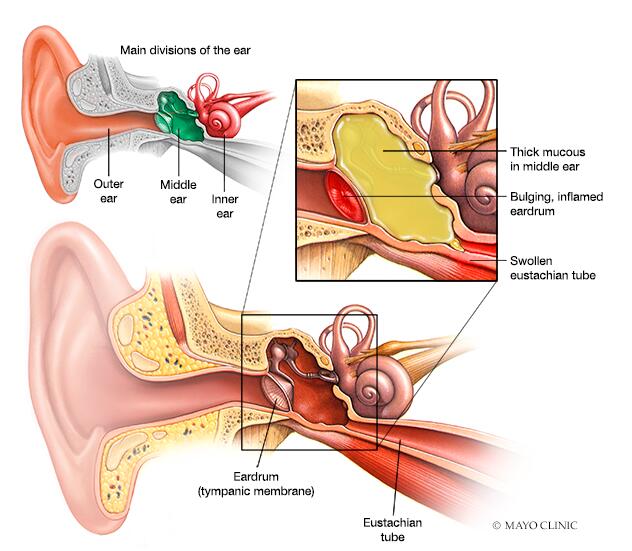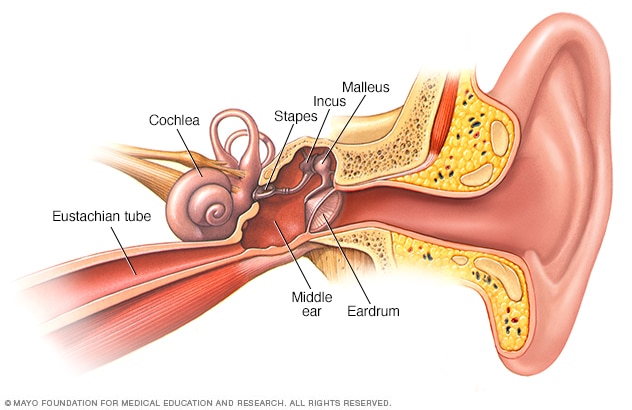Overview
An ear infection, also known as acute otitis media, is an infection of the air-filled space behind the eardrum, known as the middle ear. Children are more likely than adults to get ear infections.
Ear infections often clear up on their own. So treatment might begin with managing pain and watching the issue. Sometimes, healthcare professionals prescribe antibiotics to clear the infection.
Some people have repeated ear infections. This can cause hearing problems and other serious complications.

Ear infection
In an ear infection, narrow tubes that run from the middle ear to high in the back of the throat, also known as eustachian tubes, can become swollen and blocked. This can lead to mucus buildup in the middle ear. This mucus can become infected and cause ear infection symptoms.
Symptoms
Symptoms of ear infection often come on fast.
Children
Ear infection symptoms common in children include:
- Ear pain.
- Tugging at an ear.
- Trouble sleeping.
- Crying more than usual.
- Fussiness.
- Trouble hearing or replying to sounds.
- Loss of balance.
- Fever.
- Fluid coming from the ear, which can be from a torn ear drum.
- Headache.
- Loss of appetite.
Adults
Common symptoms of ear infections in adults include:
- Ear pain or pressure.
- Fluid coming from the ear, which can be from a torn ear drum.
- Trouble hearing.
When to see a doctor
Many conditions have symptoms of an ear infection. It's important to get a good diagnosis and prompt treatment. Call your child's healthcare professional for symptoms that are severe or for:
- Symptoms that last for more than 2 to 3 days.
- Symptoms in a child younger than 6 months old.
- Symptoms that are getting worse.
- An infant or toddler who is sleepless or cranky after a cold or other infection that affected breathing, also known as an upper respiratory infection.
- Fluid, pus or blood from the ear.
- Hearing loss.
From Mayo Clinic to your inbox
Causes
A bacterium or virus in the middle ear causes an ear infection. This infection often comes from another illness, such as a cold, flu or allergy. These can cause the inside the nose, throat and ears to be swollen and stuffy.

Middle ear
The middle ear includes three small bones. They are the hammer, called the malleus; anvil, known as incus; and stirrup, known as stapes. The eardrum lies between the middle ear and outer ear. The middle ear connects to the back of the nose and throat by a narrow area called the eustachian tube. The snail-shaped cochlea is part of the inner ear.
Role of eustachian tubes
The eustachian tubes are a pair of narrow tubes that run from each middle ear to high in the back of the throat, behind the nose. The throat end of the tubes open and close to:
- Keep air pressure even in the middle ear.
- Bring fresh air to the ear.
- Drain fluids from the middle ear.
Swollen eustachian tubes can become blocked, causing fluids to build up in the middle ear. This fluid can become infected and cause the symptoms of an ear infection.
In young children, these tubes are narrower and more level than adults' are. As a result, they're harder to drain and more likely to get clogged.
Role of adenoids
Two small pads of tissue high in the back of the nose, also known as adenoids, help fight off infection.
Adenoids are near the opening of the eustachian tubes. Swelling of the adenoids can block the tubes. This can lead to middle ear infection, especially in children.
Related conditions
Conditions of the middle ear that may be related to an ear infection or cause similar middle ear problems include:
- Otitis media with effusion. This is due to a fluid buildup, known as effusion, in the middle ear. This can happen if fluid stays in the middle ear after an ear infection has gotten better. It might also happen because of some other cause of the eustachian tubes being blocked.
- Chronic otitis media with effusion. This happens when fluid stays in the middle ear or keeps coming back. Children with this condition are likely to get new ear infections. Hearing can be affected.
- Chronic suppurative otitis media. This is an ear infection that doesn't go away with the usual treatments. It can lead to a hole in the eardrum.
Risk factors
Risk factors for ear infections include:
- Age. Children between the ages of 6 months and 2 years are more likely to get ear infections. That's due to the size and shape of their eustachian tubes.
- Group child care. Children cared for in group settings are more likely to get colds and ear infections than are children who stay home. Children in group settings come into contact with more infections, such as the common cold.
- Bottle feeding. Babies who drink from a bottle tend to have more ear infections than do babies who breastfeed. This is especially true if they're given a bottle while in their cribs.
- Seasons. Ear infections are most common during the fall and winter. People with allergies during certain seasons might have a greater risk of ear infections when pollen counts are high.
- Poor air quality. If you’re around tobacco smoke or a lot of air pollution, you have a higher risk of ear infections.
- Cleft palate. The bones and muscles in the faces of children who have cleft palates can make it harder for the eustachian tube to drain.
Complications
Most ear infections don't cause long-term complications. Ear infections that happen again and again can lead to serious complications:
- Hearing loss. Mild hearing loss is common with an ear infection. But hearing usually gets better after the infection clears. Ear infections that happen again and again or constant fluid in the middle ear can cause worse hearing loss. If there's lasting damage to the eardrum or other parts of the middle ear, hearing might not get better.
- Delays in speech or development. Hearing loss in infants and toddlers might cause delays in speaking and developing age-linked skills. This might be true even if hearing loss doesn't last.
-
Spread of infection. Untreated infections or infections that don't respond well to treatment can spread to nearby tissues. Rarely, an ear infection can cause infection of the bony section behind the ear, known as mastoiditis. This infection can harm the bone and cause pus-filled cysts.
Also rarely, serious middle ear infections can spread to other tissues in the head. This can infect the brain or the membranes around the brain, an infection known as meningitis.
- Tearing of the eardrum. Most eardrum tears heal within 72 hours. In some cases, surgical repair is needed.
Prevention
The following tips may lower the risk of getting ear infections:
-
Prevent colds and other illnesses. Teach children to wash their hands often and well. Tell children not to share cups, forks and spoons. Teach children to cough or sneeze into their elbows.
Children might have less risk of getting ill if they spend less time in group child care. Or the risk of illness might be lower if they're in child care with fewer children. Try to keep sick children home.
- Avoid secondhand smoke. Make sure that no one smokes in your home. Away from home, stay in places that are smoke-free.
- Breastfeed. Breast milk might help protect babies from ear infections if they breastfeed for at least six months.
- Hold bottle-fed babies upright while they feed. Don't prop a bottle in the mouth of a baby who's lying down. Don't put bottles in the crib with a baby.
- Getting vaccinated. Ask your child's healthcare professional what vaccinations the child needs. Seasonal flu shots and other vaccines might help prevent ear infections.